Hello there, and welcome back to yet another guitar review article. It’s been a while since I posted a guitar review article here! As you may have noticed, I have been publishing new articles on various guitar gear recently, and here we are going to continue with an electric guitar review, featuring the Fender FSR MIJ Hybrid II Stratocaster!
Table of Contents
As you may know from my previous articles here, I already own a Fender American Standard Stratocaster in Mystic Blue colour and I can confidently say that it’s probably the most stable guitar I have ever owned! Nothing has gone wrong with that guitar!
However, having played a 60’s Strat copy by SX Guitars back in the day got me always wanting a rosewood fingerboard, 60’s style Stratocaster. I was browsing through the options and considering the modern offerings by Fender. However, I couldn’t really justify getting a fully modernised Stratocaster.
Instead, I wanted to experience the vintage vibe of the iconic Strat design with slightly modern appointments. After having researched the options, I decided to go for the Made in Japan Hybrid II series Stratocaster in lovely Mystic Aztec Gold finish!
As I always do, I will provide you with a highly detailed overview and a review of this lovely instrument, as well as a no-talking sound demo video and original photos of the guitar.
First, let’s quickly have a look at the Fender company and Fender Japan briefly!
About Fender
Founded in Fullerton, California, in 1946 by Leo Fender, the Fender Musical Instruments Corporation has been shaping the sound of modern music for over seven decades. The company exploded into the spotlight with the release of the Broadcaster (soon renamed the Telecaster) in the early 1950s—the first mass-produced solid-body electric guitar. Shortly after, the Stratocaster followed in 1954, and both models remain iconic to this day.
Fender has long been synonymous with innovation. Aside from guitars, they were instrumental in developing electric basses, introducing the Precision Bass in 1951 and the Jazz Bass in 1960, completely changing the role of bass guitar in popular music.
Despite changes in ownership over the years, Fender has remained rooted in a spirit of accessibility, innovation, and unmistakable style. From surf rock and blues to punk, pop, and metal, Fender has been there every step of the way—and continues to be a key player for players of all levels.
About Fender Japan
Fender Japan, Ltd. was a joint venture launched in March 1982, bringing together Fender USA, Fujigen Gakki, and Japanese distributors Kanda Shokai and Yamano Music.
The alliance was established to counteract a growing flood of high-quality—but essentially unlicensed—Japanese copies of Fender guitars, such as those from Tokai, Greco, and Fernandes.
Fujigen Gakki (FujiGen), based in Nagano, was not only contracted as the primary manufacturer but also held significant equity in the venture and contributed actively to decision-making.
Kanda Shokai and Yamano Music handled distribution—Kanda owned the Greco brand and agreed to cease producing Greco Fender copies as part of the deal
Production Timeline & Labels
Made in Japan (MIJ) guitars: Produced by FujiGen from approximately 1982 to 1995
Crafted in Japan (CIJ) guitars: Starting around 1995–1996, production shifted to include Dyna Gakki, with “Crafted in Japan” marking guitars from then until 2015
Production under this joint venture ended on March 31, 2015. From April 1, 2015, Fender America took over directly through Fender Music Corporation (Japan), introducing the Japan Exclusive series.
The most important reason for Fender to support Fender Japan was to reclaim market share and prestige in Japan amid unfair competition from high-quality replicas.
Manufacturers like Tokai had earned reputations for craftsmanship, even prompting Fender to react directly by establishing this venture.
By leveraging skilled Japanese craftsmanship, Fender Japan produced instruments with exceptional build quality and fidelity to both vintage Fender specs and unique, Japan-exclusive designs.
Fender Japan also exported some models under the Squier Series label around 1982, allowing Fender to avoid cannibalising U.S. sales. These early JV-era instruments are now prized for their quality and collectability.
Offset models shine: Fender Japan’s Jazzmaster, Jaguar, and Mustang variants gained global acclaim, rekindling interest in these offset classics and even influencing metal and alternative genres.
Recent releases, such as the Traditional Collection and Made in Japan Heritage Series, offer vibrant aesthetics—from Sakura Telecaster finishes to bold Competition stripes—while honouring 1950s and ’60s specs with modern playability.
Fender Japan also focuses on releasing Hybrid models that bring modern and vintage vibes together on the same instrument!
Fender FSR MIJ Hybrid II Stratocaster – Mystic Aztec Gold
Fender FSR MIJ (Made in Japan) Hybrid II Stratocaster belongs to the Hybrid II series, which Fender Japan has recently released. This particular model features a lovely Mystic Aztec Gold (MAG), and it’s (was) a limited edition.
I believe I got one of the last brand-new ones from Thomann, as this guitar was removed from the website as soon as I bought it! 🙂
Although I did my best to research this instrument online, as always, Fender removed all the product pages and relevant information of the Fender Special Run MIJ Hybrid II MAG Strat from the websites (even from Fender Japan) right after it got discontinued.
It may also be due to they never even had a product page for this exclusive, limited-edition version. So, if you have one of these guitars, you should consider yourself lucky! 🙂
Let’s start with some original photos of this guitar below! As you can see, it’s a lovely gold finish! I can easily say that this looks so much sexier and cooler in person!
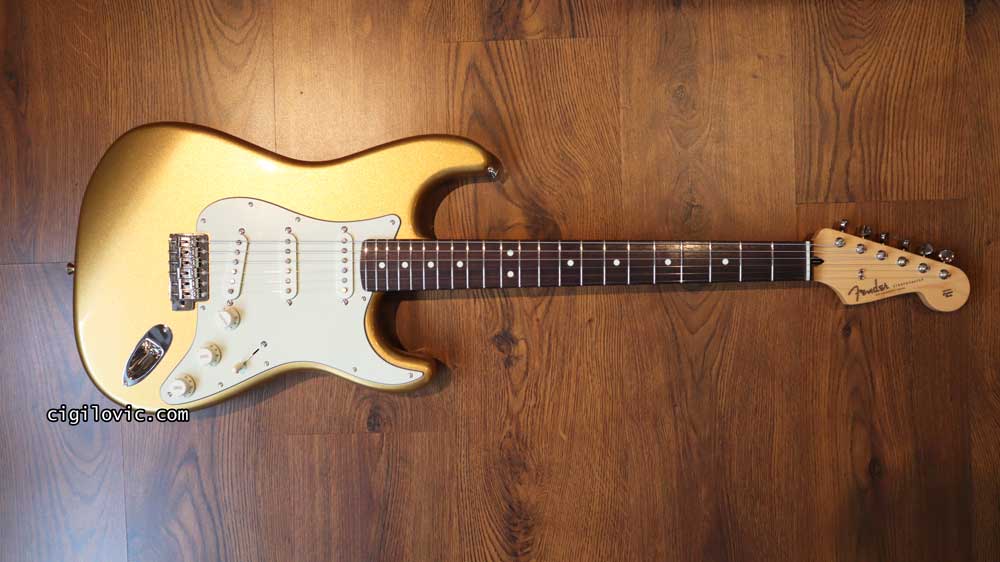
Even though I tried hard to browse the internet archives, I couldn’t find a copy of the official Fender product page for this guitar. But, still, we have the tech specs and everything we need! 🙂
I must admit that it took me a while to comprehend what’s so hybrid about this guitar. But then I realised what this is all about and acknowledged this wonderful offering.
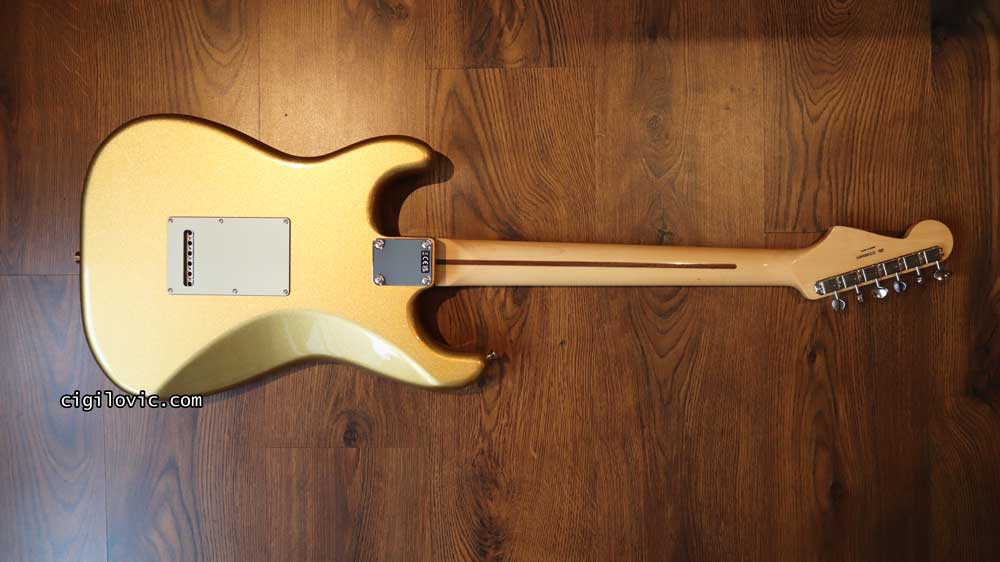
What’s So Hybrid About This Strat?
The actual amount of “hybrid” flavours in this Stratocaster design is pretty low! I tried to remember my experience with Stratocasters as well as the clones back in the day while serving in the musical instruments industry, and realised that this guitar is pretty much a very traditional 60’s Stratocaster with medium jumbo frets (at first glance!).

Before we do a deep dive with individual sections of this Strat, let’s first have a quick look at the tech specs below!
Fender MIJ Hybrid II Stratocaster Tech Specs (FSR Mystic Aztec Gold)
| Fender MIJ Hybrid II Stratocaster Tech Specs | Tech Specs |
|---|---|
| Body | Alder |
| Body Finish | Gloss Urethane |
| Design | Stratocaster |
| Neck | Maple |
| Neck Finish | Gloss Finish |
| Neck Shape | Modern "C" |
| Scale Length | 25.5" (648 mm) |
| Fingerboard | Rosewood |
| Radius | 9.5" (241 mm) |
| Number of Frets | 22 |
| Fret Size | Medium Jumbo |
| Nut Material | Bone |
| Nut Width | 1.65" (42 mm) |
| Position Inlays | White Dots |
| Truss Rod | Bi-Flex |
| Pickups | Hybrid II Custom Voiced Single Coil (Bridge, Middle, Neck) |
| Controls | Master Volume, Tone 1. (Neck & Middle Pickup), Tone 2. (Bridge Pickup) |
| Configuration | SSS |
| Bridge | 6-saddle vintage-style synchronised tremolo |
| Hardware Finish | Chrome |
| Tuning Machines | Vintage-Style Locking |
| Pickguard | 3-Ply Mint Green |
| Control Knobs, Switch Tip | Mint Green Plastic |
| Strings | Fender Super 250L, NPS, (.009-.042 Gauges) |
| Included Accessories | Gigbag |
| Made In | Japan! |
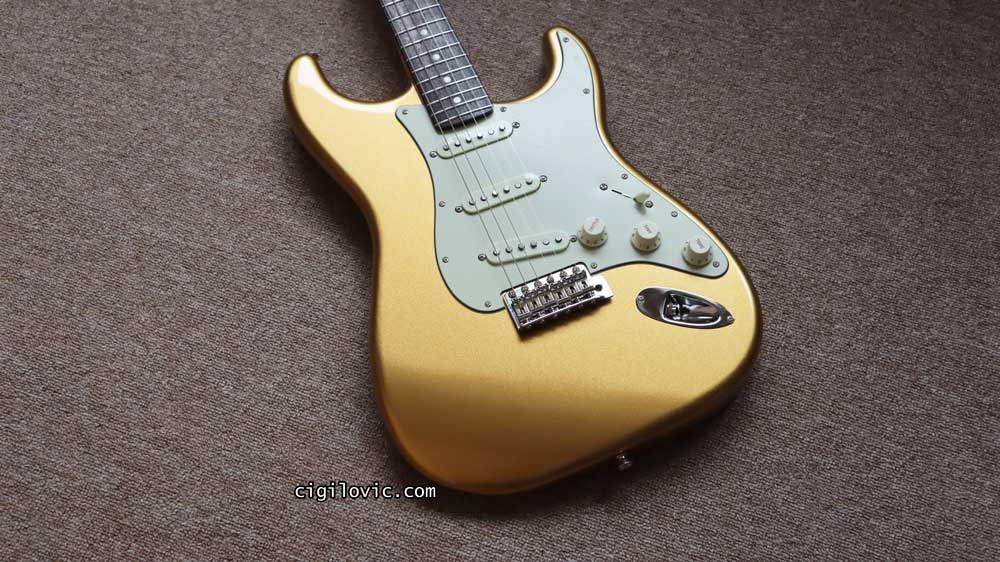
Just have a quick look at the tech specs table and take a guess what’s so hybrid about this guitar! I think the only thing that is modern on this guitar is the frets! 🙂
This particular FSR MIJ Hybrid II Strat features medium jumbo frets. Apart from that, it’s not easy to interpret all the features offered as modern at all. Everything about this guitar feels vintage except the fret size!
Is it bad? Of course, not! If you have spent long enough time researching Fender’s offerings, you will see a pattern. I mean, at the end of the day, the thing they can offer is to give us options with different feature sets, right?
Think about the modern & ultra series Strats. They offer very modern feature sets while preserving the core Strat design. However, most of the time, what they offer is always on the modern-heavy feature sets. Ads - Check out these ads to support this web page
On the other hand, Fender also needs to satisfy the vintage guitar lovers and manufacture authentic, vintage feature sets. Unfortunately, it’s not always easy to find all the feature sets that fit your preferences.
Personally, I’m not a big fan of all vintage specs, especially the narrow, vintage frets. Also, I don’t like to deal with a nitro finish on my guitars.

When it comes to bridges on the Strats, I prefer a modern, 2-point synchronised tremolo. Not a 6-screw version! 🙂 I’d also love to have a roller nut on my Strats so I can use the tremolo more often without having to worry about the tuning issues.
As you can see, this guitar already doesn’t fit in my preferences. But I’m also craving the experience of a vintage Strat design.
Mind you, there are also other options from the Hybrid II series which offer different modern features. For instance, the Fender MIJ Hybrid II Strat MN Flame model features all the vintage specs, but with a 2-point tremolo and a flame maple top with narrow frets.
See how they sprinkle the modern features into the vintage framework. I think this series is a very interesting one! If it fits your preferences and configuration needs on the vintage side, you may have found your ideal guitar!
As I always do, I have prepared a no-talking style sound demo video of my Fender FSR MIJ Hybrid II Stratocaster, limited edition Mystic Aztec Gold guitar for you!
Let’s first watch the video and hear the guitar. Then, we will go into details, and I will provide you with my review and verdict.
In this video, I used a slightly different setup than in my previous videos. Recently, I have been experimenting with a tube preamp-based rig around my Brunetti Mille CR Preamp.
I used my Fender Special Run MIJ Hybrid II Stratocaster (with Fender Super205L strings) along with the preamp, Two Notes Opus, Boss SD-1, Maxon ST9Pro+ as booster pedals, MXR Carbon Copy Deluxe, Ibanez Pentatone EQ, Ibanez CSMini Chorus and Dunlop MC-404 CAE Wah pedal powered by Cioks DC7.
This signal chain is directly recorded into Reaper via the RME Babyface PRO FS interface and monitored via Genelec 8020 DPM monitors. The only effect is the Wave Alchemy Magic7 reverb, which is a freeware one (definitely check this out!).
Unfortunately, I made a mistake by activating the parallel FX loop on my preamp instead of the serial one. So, there’s constant noise in the background, even though I had a gate attached to the signal chain. 🙂
Fender FSR MIJ Hybrid II Stratocaster Review & Sound Demo (no talking)
Fender MIJ Hybrid II Stratocaster Review (FSR, Limited Edition, Mystic Aztec Gold)
As I mentioned above, this series, as well as other series offered by Fender, is a matter of configuration fit for the player. Even though there are different variations offered in the MIJ Hybrid II Series, it’s mostly a sprinkle of modern features into a vintage framework (at least, this is what I understood from this series!).
The Gig Bag
I’d like to start with possibly the only negative remark here. The guitar comes in a standard Fender packaging, just a simple cardboard box, wrapped in a plastic guitar packaging material and in a very standard gig bag.
Yes, the gig bag! I paid around 1500EUR for this guitar here in the EU, and I was so surprised when I saw the gig bag! Even my FGN Boundary Odyssey (made in Japan) guitar came in a really nice, padded gig bag for less than half the price of my Fender.
I think this was a bad decision, Fender! I mean, how much do you need to maximise your profits by giving us the bare minimum quality, standard gig bag? I’ll never understand this.
You could easily add a padded gig bag at this price tag without any issues on the financial side of things, right? 🙂
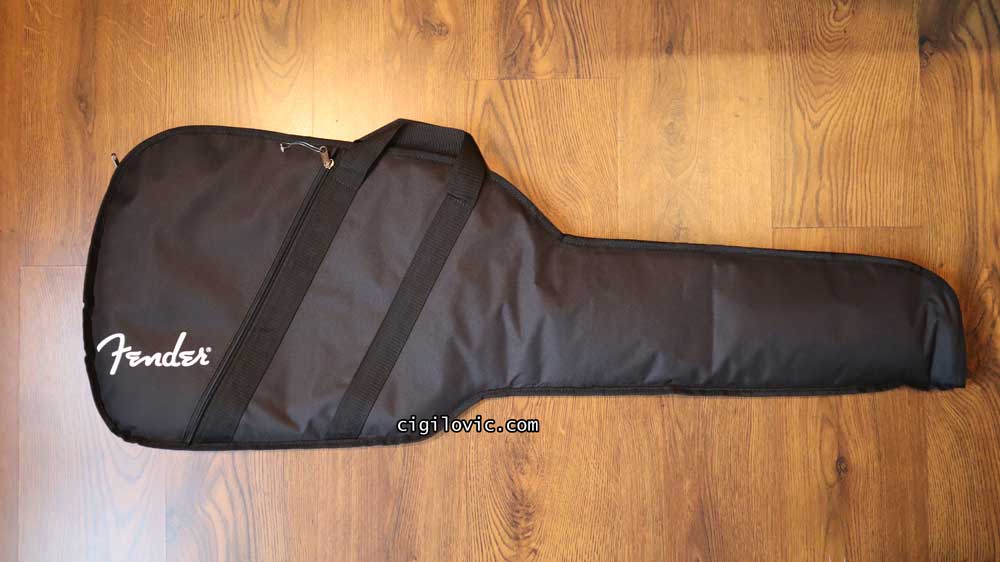
The Box Content
Apart from the gig bag, the guitar comes with a standard tremolo arm and a pair of allen keys to adjust the truss rod and the bridge saddles. That’s all!

As a side note, the tremolo hole on the bridge didn’t come covered, as with all the Strats I have unboxed so far. So, I couldn’t be sure if there was a spring inside the hole. I had a quick look into the hole and couldn’t see any.
For that reason, I got a set of Fender Tremolo Bar Springs to further tighten the bar. Works like a charm!
Apart from the usual box contents, the guitar also comes with an inspection chart that includes the product code, as shown below.
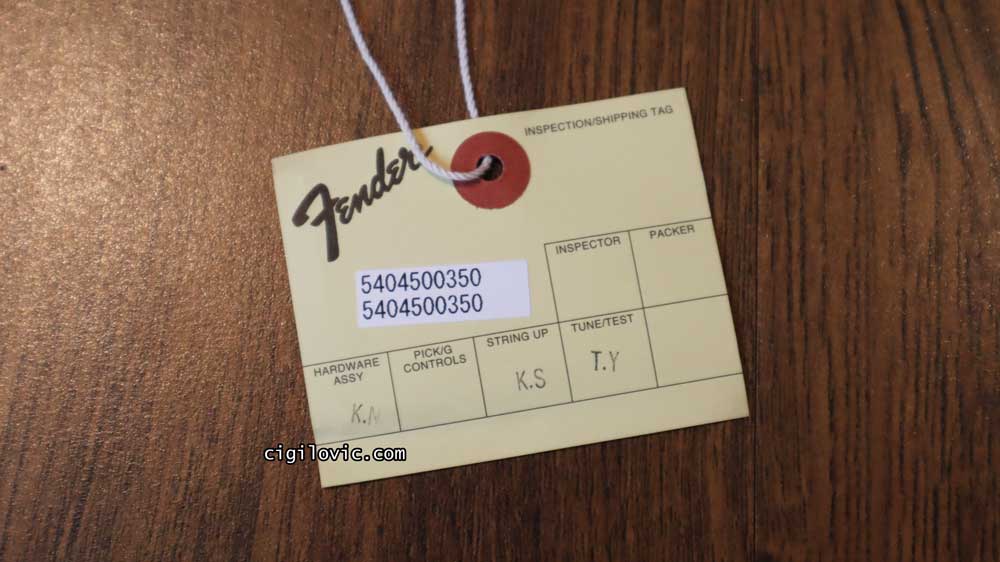
Just to give you all possible details, here’s another shot from the back of the QC card. This part includes quick information on the string replacement.
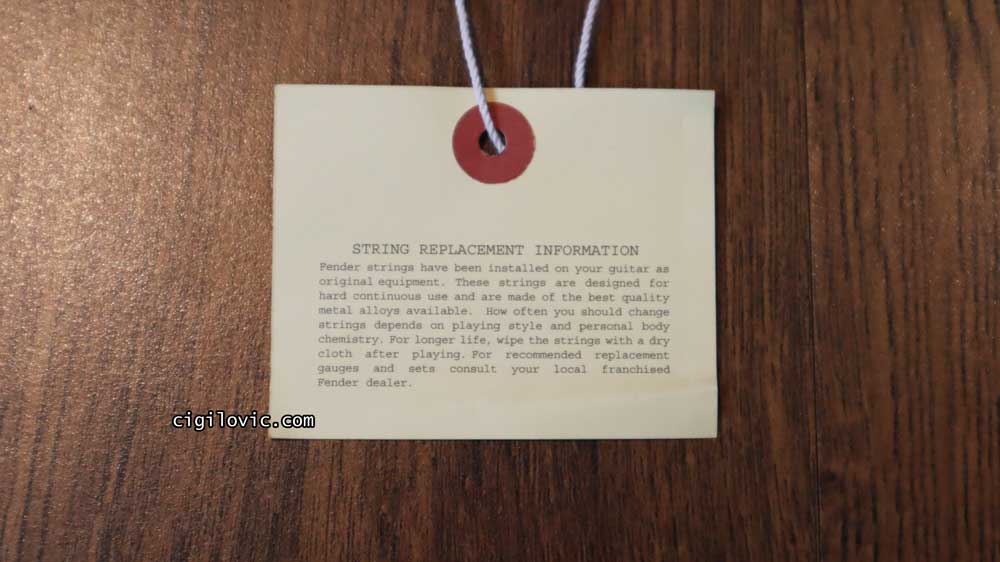
Lastly, the guitar also comes with this Cancer and Reproductive Harm warning card. My FGN also came with the exact same card. I wonder why! 🙂

You can take this as a silly joke and the core of my review, but, this guitar is worth having cancer and not having kids! 🙂
Headstock
The headstock on this guitar is a classic, Fender Stratocaster-style headstock featuring the classic Fender logo. As the tuners are not staggered, it also features a standard string tree.
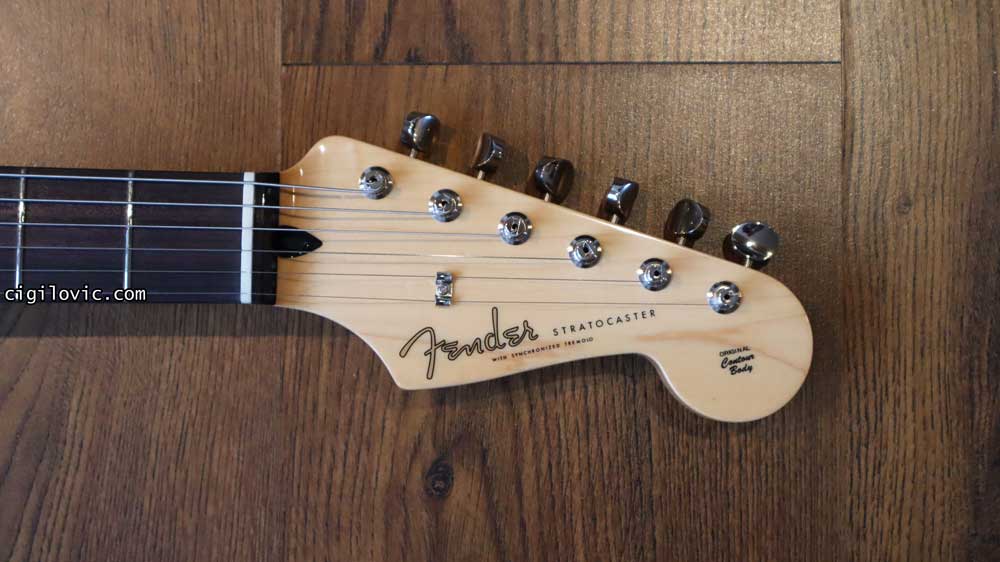
The string tree is installed perfectly and does not create any ringing sound. However, I have a spare Graph Tech string tree, and I may replace it with this plastic one as Graph Tech definitely improves the tuning stability here.
I tested this Graph Tech PT-7004-00 on my FGN and really liked the results!
Nut
According to tech specs, this nut is a bone one, and it’s really well cut. So, well done to Fender Japan! There are no significant tuning stability issues, but expect tuning issues while using the trem a bit wildly. Ads - Check out these ads to support this web page
As much as I want to believe that you can solve tuning issues by upgrading the nut, tuners and string trees, I know for sure that if you don’t eliminate the nut in the equation, you may always experience tuning issues.

On the back of the headstock, we have the standard Made in Japan label as well as the serial number. Weirdly, this serial number doesn’t show up on Fender’s Serial Number Lookup page.
Tuners
As you can see, tuners are also giving us the vintage vibes. These may be Gotoh ones, but I can’t be sure. What I’m sure about is that these tuners are one of the smoothest ever!
They rotate like butter and hold up the tuning very well!

Neck
The neck is beautifully carved, a Modern C shape neck made out of maple, and it features a skunk stripe on the back, meaning that the truss rod adjustment is done on the headstock side without removing the neck.
Maybe we can add this feature to the modern feature set category? I’m not sure, but I think we can! It’s a fairly modern feature to make truss rod adjustments without removing the neck.
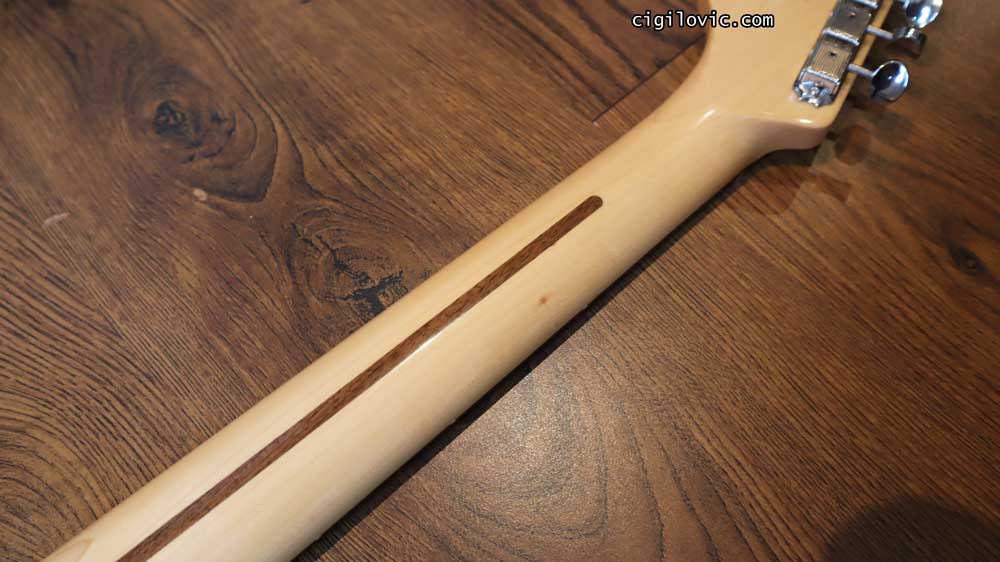
The neck profile is important here. Even though it’s a Modern C profile, I would say this is one of the slimmest Fender C shape neck profiles I have ever played.
You may be surprised, but it reminded me of my cheap, old SX SST62 Stratocaster copy! My SX also featured a very slim C profile, which I enjoyed so much!
You may be even more surprised that my current Fender American Standard Stratocaster (2013) features the same neck profile; however, it’s way more chunkier!
When I switch between my Made in Japan and Made in America Strats, I immediately feel it! It’s so obvious and pronounced!
Fingerboard
Next up, we have the fingerboard! I have added a couple of extra shots here for you to enjoy this lovely, dark rosewood fingerboard!
It’s one of the greatest-looking and feeling rosewood fingerboards I have ever played!
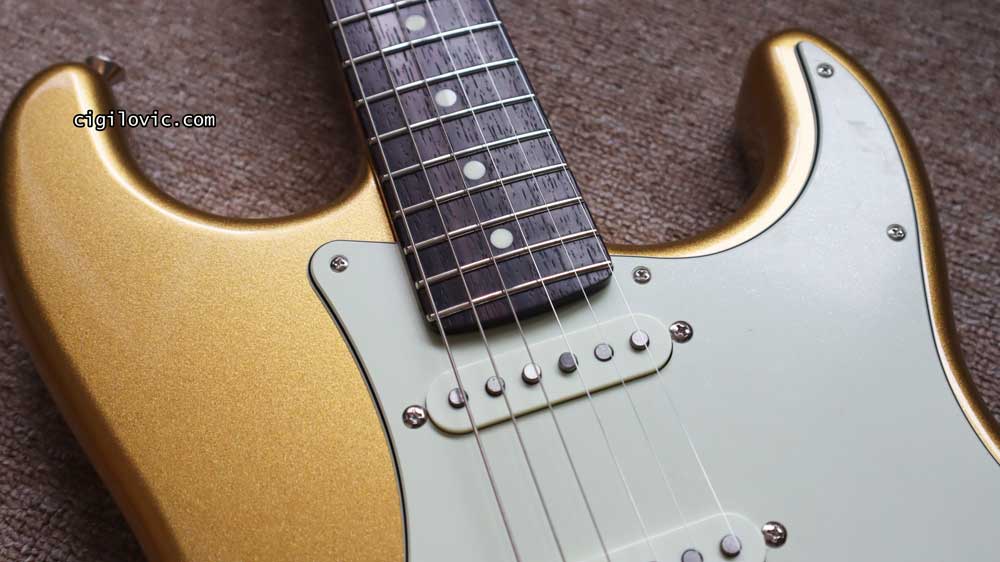
It almost looks like a polished, glossy rosewood fingerboard, and I think it’s really cool! There are minor tooling marks on the fretboard, but it’s very difficult to spot them if you don’t look for them.
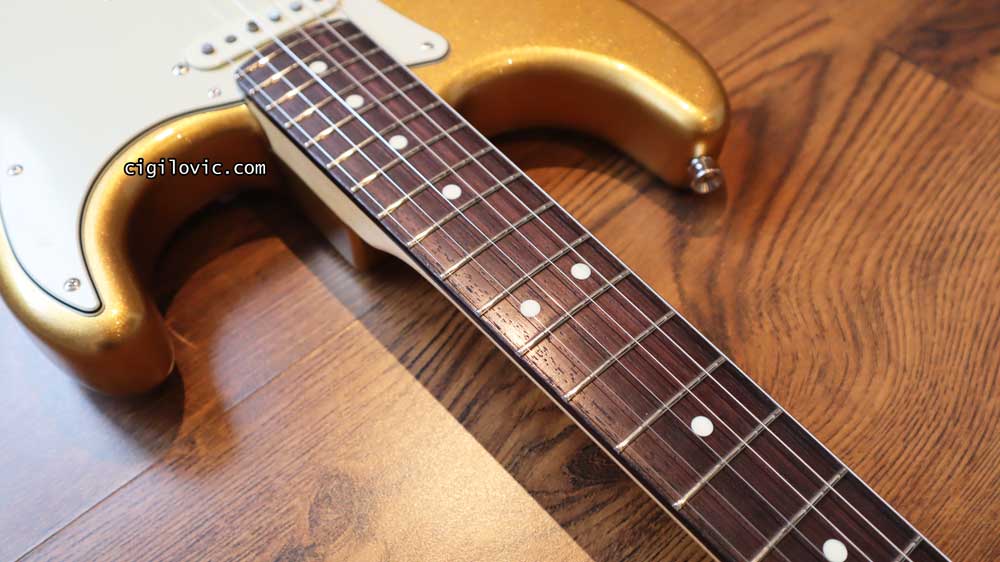
Frets
As mentioned, I think medium jumbo frets are one of the top modern features of this guitar. I think medium jumbo frets are the ideal fret size for almost everyone! That’s just my opinion, but I don’t think one ever needs narrower, shorter or wider, taller frets.
The fretwork is amazing! I have spotted zero issues! It’s so well-made, just like you would find on a custom-built guitar. Well done, Fender Japan!
Body
As you may guess, the body is a typical Fender Stratocaster build. It’s made of Alder and sounds, feels great! This particular Mystic Aztec Gold is so lovely and excellently done!
There are no issues with the paint and finish job. I can’t stop looking at this guitar. Seriously, one of the best gold finish variations I have ever seen in person!
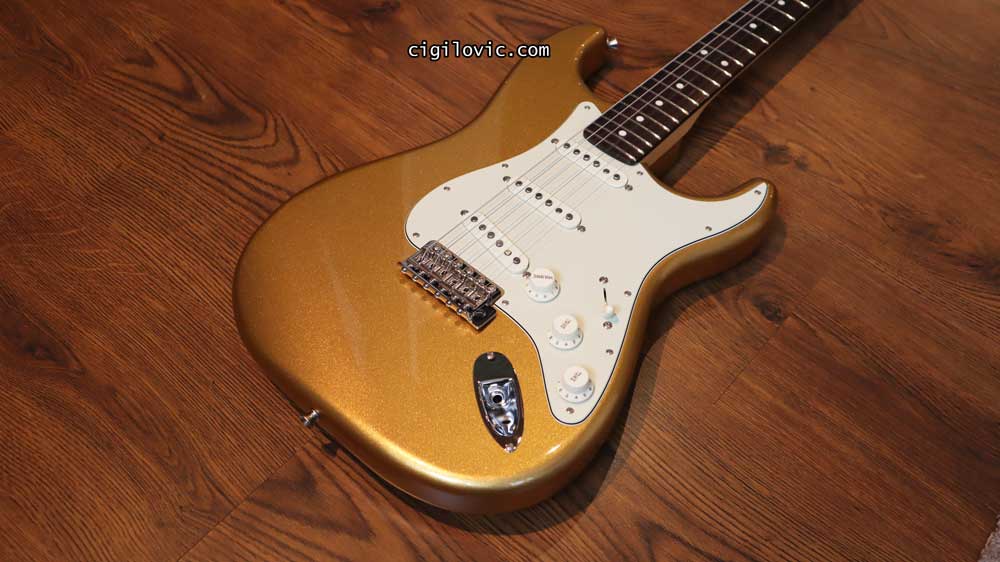
Pickguard & Plastics
One of the most beautiful things about this guitar is the colour choice for the pickguard and the plastics. The pickguard and tremolo cover come in a lovely mint green colour, which complements the gold finish as well as the dark rosewood fingerboard.
The rest of the plastic parts are coloured white. Although some tech spec charts stated that these are all eggshell white, I’m unable to distinguish these colours.

Bridge
Fender MIJ Hybrid II Strat, Limited Edition MAG features a 6-screw, vintage-style bridge with bent steel saddles. As you may know, this is not so much praised over a 2-point one with steel block saddles version.
To be honest, I don’t think it’s going to create a lot of tuning issues just because it has a 6-screw design. However, I’m not a big fan of the bent steel saddles as they wear a lot quicker than the block ones.
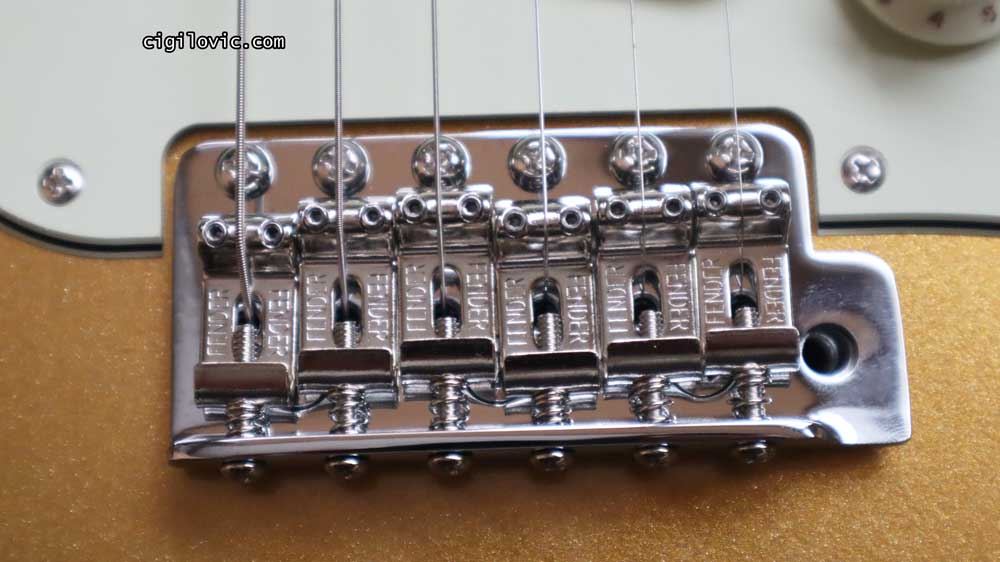
Here, I’m sharing an image of the tremolo and how it comes out of the factory. It’s installed most cleanly and works like a charm right out of the box.
The tremolo block has a nice weight to it, and it’s really easy to shake chords and single notes. As I mentioned above, I wasn’t really sure if it came with a bar spring, as the hole wasn’t covered with a sticker.
So, I installed a new one, and it helped with the stiffness of the tremolo bar.
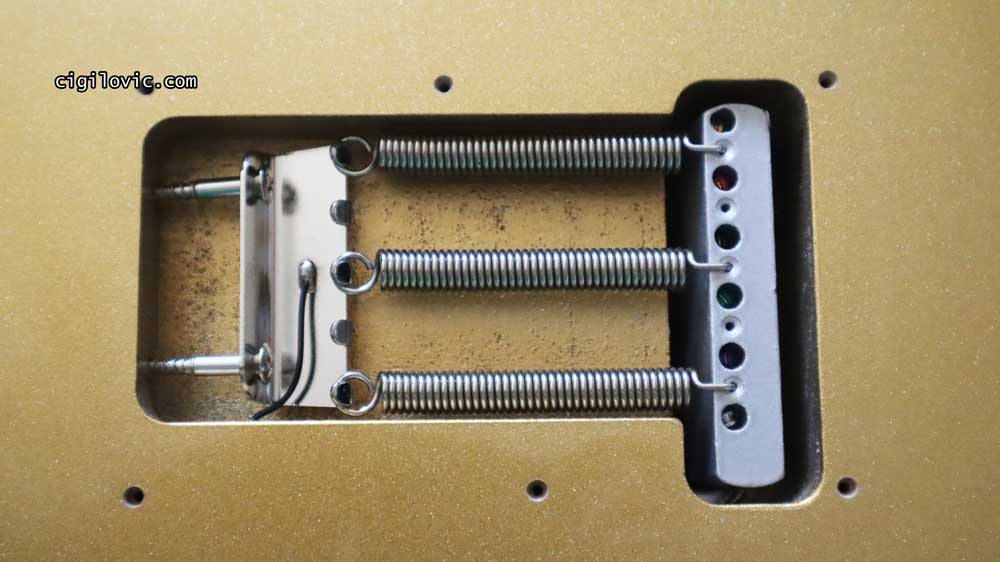
Pickups & Electronics
The pickups on this guitar are Hybrid II Custom Voiced Single Coil for all positions. I will add the readings and share them with you here soon. However, I remember the middle pickup was slightly hotter than the rest, which was weird.
As you can see from the image below, these have staggered pole pieces to compensate for individual string volumes. To me, it’s a new and weird look as I’m not used to seeing these on my Strats.

To me, these pickups sound so much more vintage than my Custom Shop Fat50s on my American Standard. They are not as full, big or ballsy as the Custom Shop Fat50s.
But, they definitely sound like a very typical Strat single coils. I hope the video I made is good enough for you to get a feel of the tones. Hopefully, I will prepare some quick comparison videos between my two Strats, mainly to compare the pickups!
Verdict
Where to begin? I can quickly tell you that the Fender MIJ Hybrid II Stratocaster (FSR, Limited Edition, Mystic Aztec Gold) particular model guitar, is a dream to play! I don’t think it’s overpriced or hyped at all!
The build quality, craftsmanship, fit and finish, fretwork and everything around these are top notch! It doesn’t feel like a 1500EUR guitar, and I think it was underpriced.
Shitty Gig Bag
As I mentioned, the biggest disappointment was getting a shitty gig bag with a guitar. I’m not a big fan of hardcases, but I’d love to have a proper, padded gig bag to protect this instrument. The gig bag that comes with it is just like the ones that are given away as a gift with entry-level guitars.
Vintage or Modern?
On top of this, there’s the topic of how vintage or how modern this hybrid series feels. To me, it’s almost perfectly balanced for people who seek full vintage vibes with some modern features.
Let’s talk about modern features that a guitar can offer, specifically on a Strat design. Minimum medium jumbo fret size, maybe stainless steel frets, particularly modern truss rod adjustment (not having to remove the neck for a simple neck adjustment), modern, slim neck profile, 2-point modern tremolo system with steel block saddles, noiseless single coil pickups, modern, staggered, locking tuners, roller nuts, advanced switching systems, poly urethane finish that will last a lifetime and a modern, comfort cuts on the neck joint for better access to high registers.
On the other hand, let’s have a look at the vintage features on the Strat. Thick, chunky neck profile, no truss rod adjustment without removing the neck, narrow, shorter fret size, vintage sounding pickups, vintage style bridge and tremolo system, leaner switching systems, nitro cellulose finish and vintage style tuners.
As you can see, there are not many modern features featured on this guitar. So, it’s basically a very vintage vibed Strat design with some modern appointments around the classic, vintage specs.
I would say the modern C profile neck, which is very slim, truss rod adjustment and the medium jumbo frets are the modern features of this guitar. The rest of the features are not so modern and progressive. Let me know if you agree.
This was exactly why I went for this guitar. Even though I appreciate modern features on a Strat or any other guitar, I also want to experience how these guitars came to be back in the day. For that need, I would normally need to go for the fully vintage reissue offerings that Fender has at the moment.
I was even looking at the American Vintage series, and I couldn’t justify the price tag, nitro finish and small frets at all. When I looked at the modern versions, I was also stuck with noiseless pickups, 2-point tremolo with steel block saddles, but still with medium jumbo nickel frets rather than stainless steel ones, while having to stick with a slightly modern truss rod adjustment system rather than having it on the neck heel.
When I looked at the entire overview, I made a decision to go with the vintage spec set while trying to have the critical modern feature set. And voila! Enter Fender MIJ Hybrid II Stratocaster (FSR, Limited Edition, Mystic Aztec Gold)!
Where to Buy Fender MIJ Hybrid II Stratocaster (FSR, Limited Edition, Mystic Aztec Gold)?
As I mentioned (+realised), this particular model was an FSR, meaning that it was a limited edition, Fender Special Run instrument. So, it’s almost impossible to find a brand new one at the moment. However, there may be web stores still listing this item as brand new. For that, you should Google this instrument and constantly check.
However, if you are interested in other offerings under the Fender MIJ Hybrid II series, I highly recommend that you check out Thomann’s website.
Check out Fender MIJ Hybrid II on Thomann here
Most of the other sellers on the internet and also on Reverb may offer some MIJ Hybrid II guitars; however, it may not be possible to purchase one at any given time. You may need to research Reverb and other used guitar marketplaces online.
Check out Fender MIJ Hybrid II on Reverb here
I hope you have enjoyed this real guitar review article and the materials provided here. Thanks for visiting my blog and supporting me so far! I will hopefully see you in the next review here!
Osman Cenan Çiğil – cigilovic.com
Post your comments and feedback here
By submitting a comment, you accept that you will be automatically included in the newsletter. You can always opt out in case you are not interested in the content updates.Check out the best used gear website!




